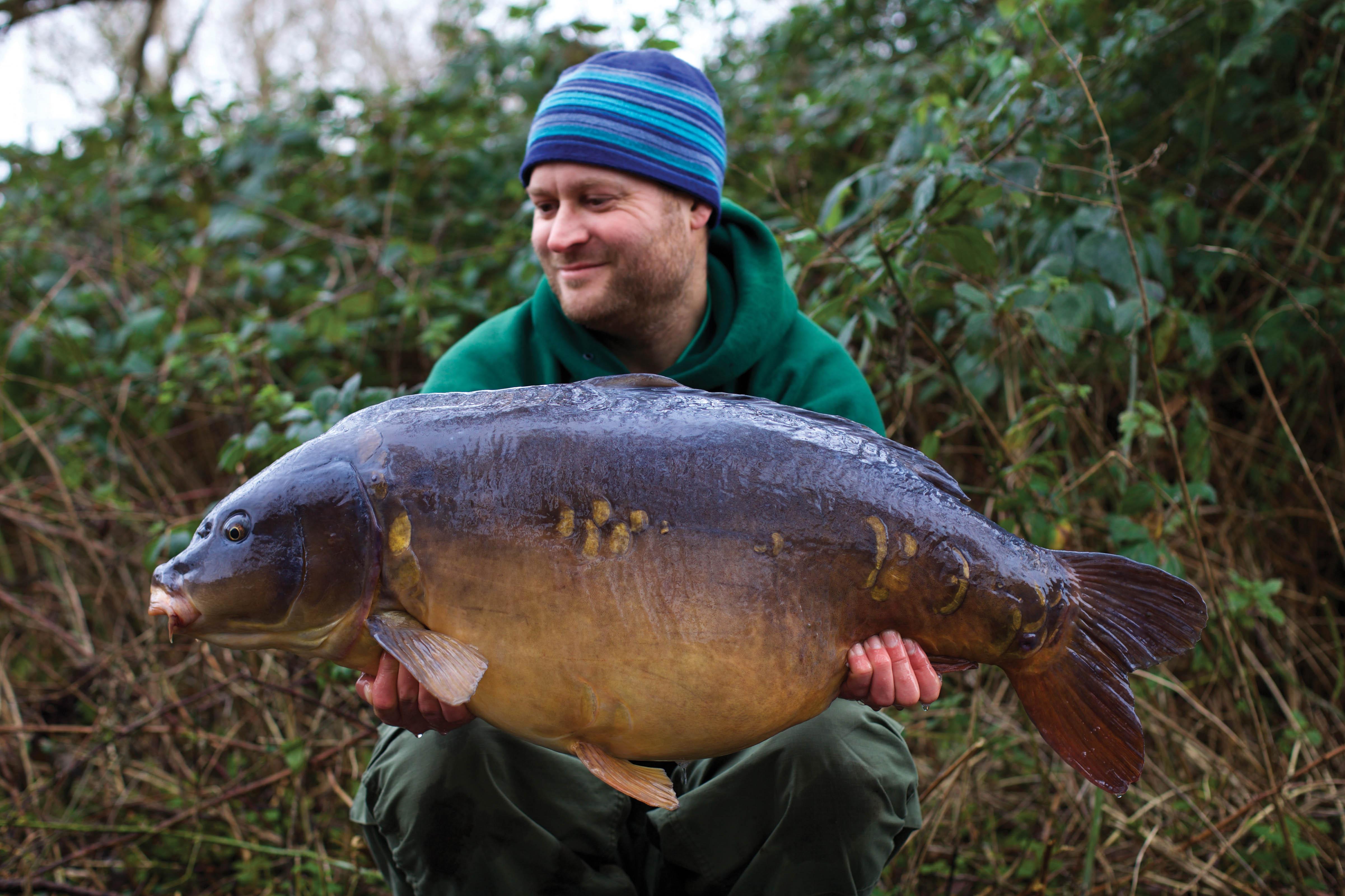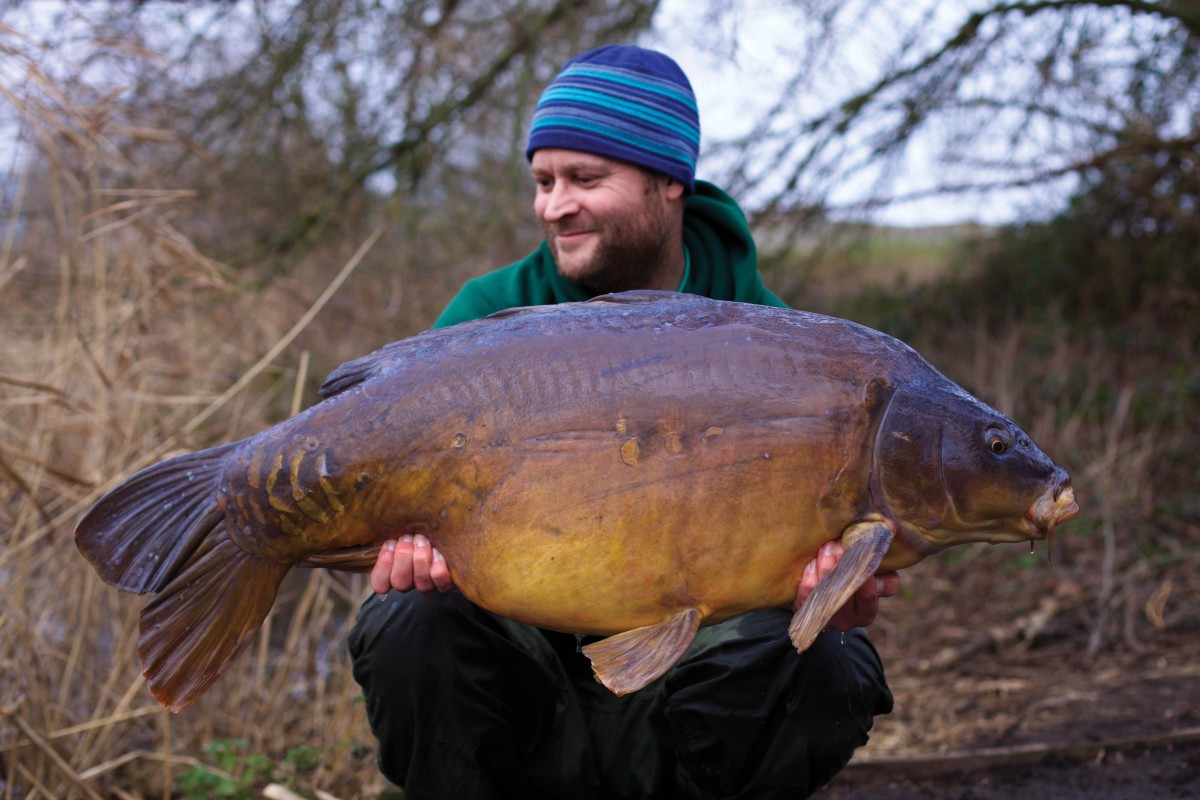
A Winter To Remember!
A former sailing lake provides some spectacular cold-water carp fishing for Aaron Copp
Having spent the spring and early part of the summer on the former sailing lake, the postman delivered the ticket I had applied for a few months earlier. It was one for a water I had everything crossed to be accepted for: the famous Savay! Whilst I had really enjoyed my start on the sailing lake, the opportunity to fish Savay was one I grasped with both hands. Savay received several stockings from Donald Leney between 1950 and 1968, and amazingly, some of those original carp are still swimming, and are well over 50-years-old! With the impact of HS2 hanging over the water, and as mentioned, with some seriously old fish still present, it was a case of now or never. Well, I am pleased to say my time on Savay that summer could not have gone any better. Utilising a mobile approach, several margin opportunities came my way, and they resulted in some rather memorable captures.
With the autumn fast approaching, I had a decision to make: continue on Savay, or head back to the former sailing lake. Whilst it was very tempting to see whether I could keep my run of Savay fish going, I also had to be realistic. My experience over the years has shown that on most lakes, bite time moves into the hours of darkness in the autumn. My Savay ticket was days only (6 a.m. to 9 p.m.), and whilst I am not saying that you can’t catch during daylight hours at this time of year, on a renowned challenging and low-stocked venue, having to reel in at bite time is far from ideal. With this in mind, I decided to say goodbye to Savay for the time being, and head back to Kent’s Medway Valley. As an aside, the following illustrates my point regarding autumn bite time…
Ahead of recording a podcast with Korda, host Simon Pitt invited me to join him for a two-night trip to Savay in early November (from 1 November, you can guest with a rota member at night); it was the only occasion I fished the lake after my summer day sessions. I blanked, but on the second evening, and after his rigs had been in place for almost 36hrs, Simon caught a mirror. The take came at 9:30 p.m., half an hour after a day angler would have left!
Throughout September, and as I did for the majority of the autumn and winter, I fished two nights each week on the sailing lake. Judging from the shows I witnessed, the carp were definitely pushing further out towards the centre of the pit. The 28-acre lake is roughly rectangular in shape, and at its widest, it’s around a 160-yard cast to the middle. With restrictions on lead size, line breaking strain and the use of shock leaders, the vast majority of anglers fish nowhere near the middle. As a result, the area is somewhat a safe haven for the carp. I caught steadily, though I distinctly recall a two-week period where not a lot came out at all…
Earlier in the summer, the bulk of the weedbeds had broken up. Floating rafts made the lake difficult to fish, and the majority of the gravel features out in the lake were devoid of weed. I recall chatting to Mark, a good angler and another Essex resident. With the gravel areas exposed and covered in zebra mussels, he was sure the carp were feeding heavily on naturals and not paying too much attention to anglers’ bait. My next capture confirmed his belief, a 36lb scattered linear mirror passing crushed zebra mussel shells on my unhooking mat.
Two particular trips in October stand out. For the first, I managed to get in the Fiend swim. It is centrally located on the west, or Railway Bank, and juts out somewhat into the lake. It therefore makes the job of reaching the carp at range that little bit easier. A brisk westerly wind was blowing, and after I’d been standing in the swim for just a couple of minutes, a carp showed at range. This was a swim I’d had success in during my first visit to the lake back at the start of April and the carp showed just beyond the area I’d caught from. I had one exploratory cast and as I felt the lead down, it landed with a satisfyingly dull thud - the spot was still clear. With the wind coming directly over my head, I quickly had all three rods on the spot, and proceeded to spod broken Mainline Cell boilies over the area.
Just an hour after the disturbance of getting the rods into position, another carp showed in the same area - it was looking like a quick bite may well be on the cards! The wet weather forecast duly arrived, and after the heavens opened, it literally did not stop raining for the next two nights. The rods remained motionless for this whole period. The rigs were positioned perfectly on the spot, so there was no reason to re-cast, and as a result, there was no disturbance in the swim.
Having been confined to the bivvy for practically the whole session, as soon as the weather broke on the final morning, I stood by my rods with a cup of tea in hand, scanning the water as the sun, at last, appeared during a break in the cloud cover. In a bid to keep my line away from the lethally sharp zebra mussels, my tips were high, the line bowstring-tight in the clips. When I fished this way, the takes were almost always the same: a single bleep came from the Neville, just before the line pulled from the clip and the alarm one-toned (I deliberately had the clutches set loose, so the line wouldn’t rub tightly against any mussels before I got to the rod). In the fashion just described, the right-hand rod was away, and my mug and its contents went flying as I grabbed the rod!
Given the risk of cutting off on the zebra mussels, and the Norfolk reed that lines the margins, every fight on this pit is a nerve racking affair. What’s more, as this particular fight progressed and the carp made several slow but determined runs, it was becoming clear that I was attached to a big fish. When I finally got her to the margins, I caught a glimpse of heavy scaling along her lateral line, and I then had more than a little idea of what carp I was playing. With her finally beaten, I seized the opportunity with the net, and gently moving her onto her side, I confirmed my belief; it was the Double-row Linear… all 41lb 14oz of her!
To cap the special autumn trip, just a few minutes later, the middle rod was away. The bite resulted in the capture of another scattered linear. At 31lb 7oz, she looked simply superb as the sun lit up her flanks.
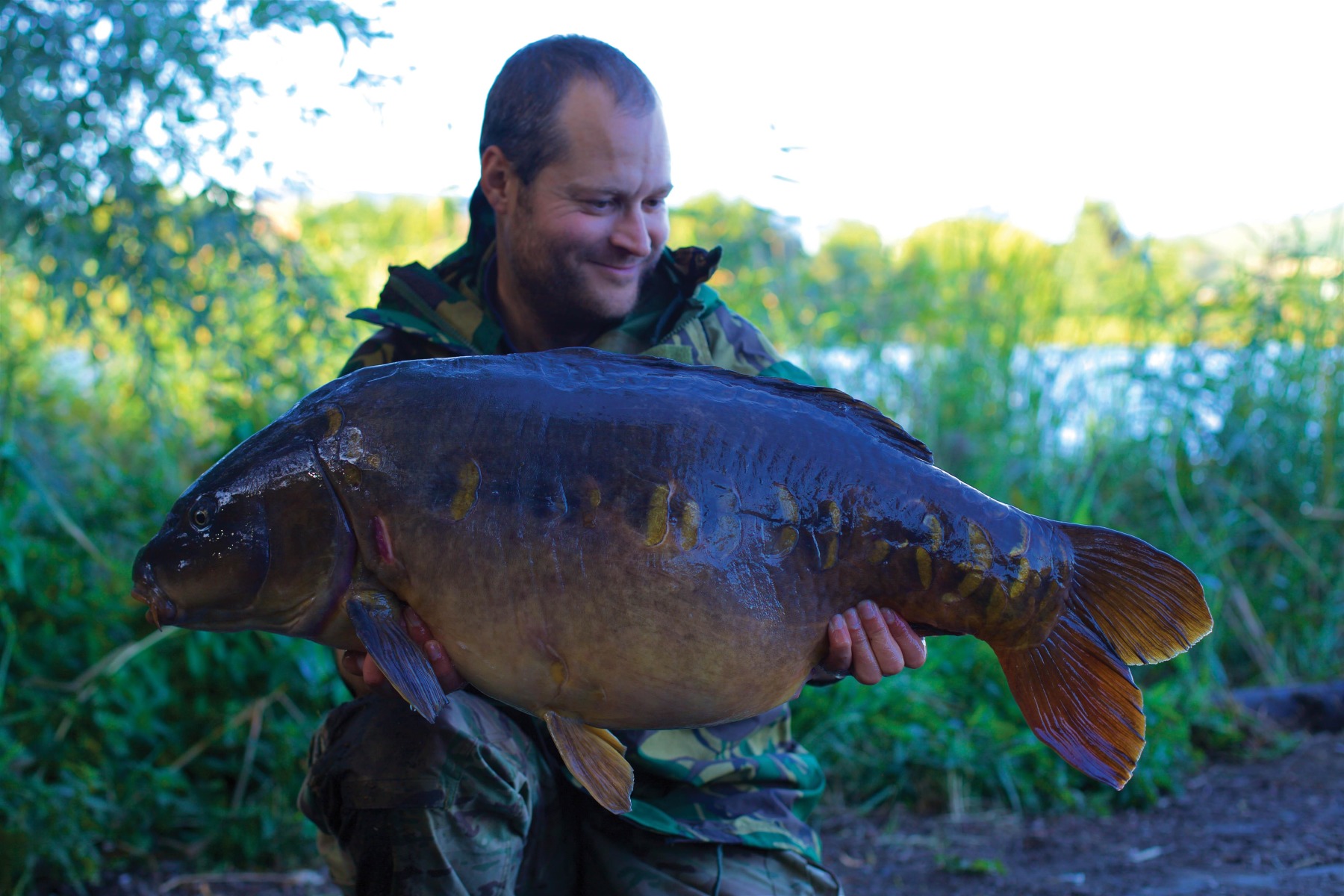

I was in the right-hand Dugout swim for my second red-letter October trip. This is an area of the lake that I really like and had caught well from in the spring. Located on the River Medway bank, the lake starts to narrow there, and with a strong westerly wind forecast (which would push straight into the swim), on arrival, I was pleased to see the Dugouts vacant, so headed straight there. I was certain there would be fish present, and after 20 minutes of watching, a carp finally head-and-shouldered. Whilst the fish was in the swim, it was much further out than I could cast, given the aforementioned restraints.
I think it’s worth elaborating a bit here. Carp tend to move away from angling pressure - anyone who’s fished a lake with an out-of-bounds area can vouch for that. On this lake, if you watch for long enough, almost always, one will eventually give away its location at range. Remember, however, they don’t have tape measures! My point is, that if you get your rigs and bait in place, and then keep disturbance to a minimum (i.e. your re-casting), then the carp will drift from the centre area in search of food.
That autumn and winter, I was to fish in some fairly extreme weather, with storms generating wind speeds as high as 60mph; this touches on another point worth dwelling on a little… If you are on a very low-stock lake, one where just one capture can make your dreams, then obviously fishing an area at your maximum capability is fine, but the former sailing lake on the other hand, contains around ten forties and a large head of high-thirties. My point here, is that multiple captures are a very real prospect, essential in fact, if you want to get amongst the big girls. That means making sure that you’re still able to get your rigs to, and spod your bait in the desired area when weather conditions get rough.
I had an area in mind already. Once again I had caught from there in early spring. It was a deep, silty spot, and a preliminary cast confirmed that it was still perfectly fishable. On many gin-clear gravel pits, the evenings in the autumn and winter can be absolutely key, and this lake is no different. I have little doubt that their confidence grows when darkness arrives. I had the rigs and bait in place by lunchtime, with all three rods fished with slow-sinking bottom baits over spodded broken Cell that would settle gently on the silt. The first bite came just after 8 p.m. and produced a 22lb common. Just half an hour later, I landed a lovely 29lb 12oz fully scaled mirror.
The strong wind was still to arrive, and I quickly got both rods back out. Proving that I’d done enough, at just after 11 p.m., I was away again. This time, after a much more drawn-out fight, I banked a thickset mirror of 36lb 3oz.
A bite the following morning produced a 26lb 12oz mirror. I was seeing very little in the way of shows, though judging by the action, it was clear I was on a number of carp. At midday I spodded out my remaining bait, and just before dusk I was away again with a 33lb 11oz mirror. The wind finally arrived later that evening. The feeling was electric. I was thinking that at any moment, a rod was going to tear off, but it never happened. I may have overdone it with the bait, or maybe it had pushed them back out. Either way, I made amends on the final morning by catching another striking fully scaled fish that weighed 29lb 9oz. Just before I left, I had an absolute powerhouse of a mirror that went 37lb 6oz. My sharpened size 4 Wide Gapes were delivering solid hook-holds, and I landed all seven bites.
I didn’t fish the following week due to a family holiday, and the next trip coincided with the arrival of the first real cold snap. I managed to get back in the Dugout, but to no avail… I saw very little and ended up blanking.
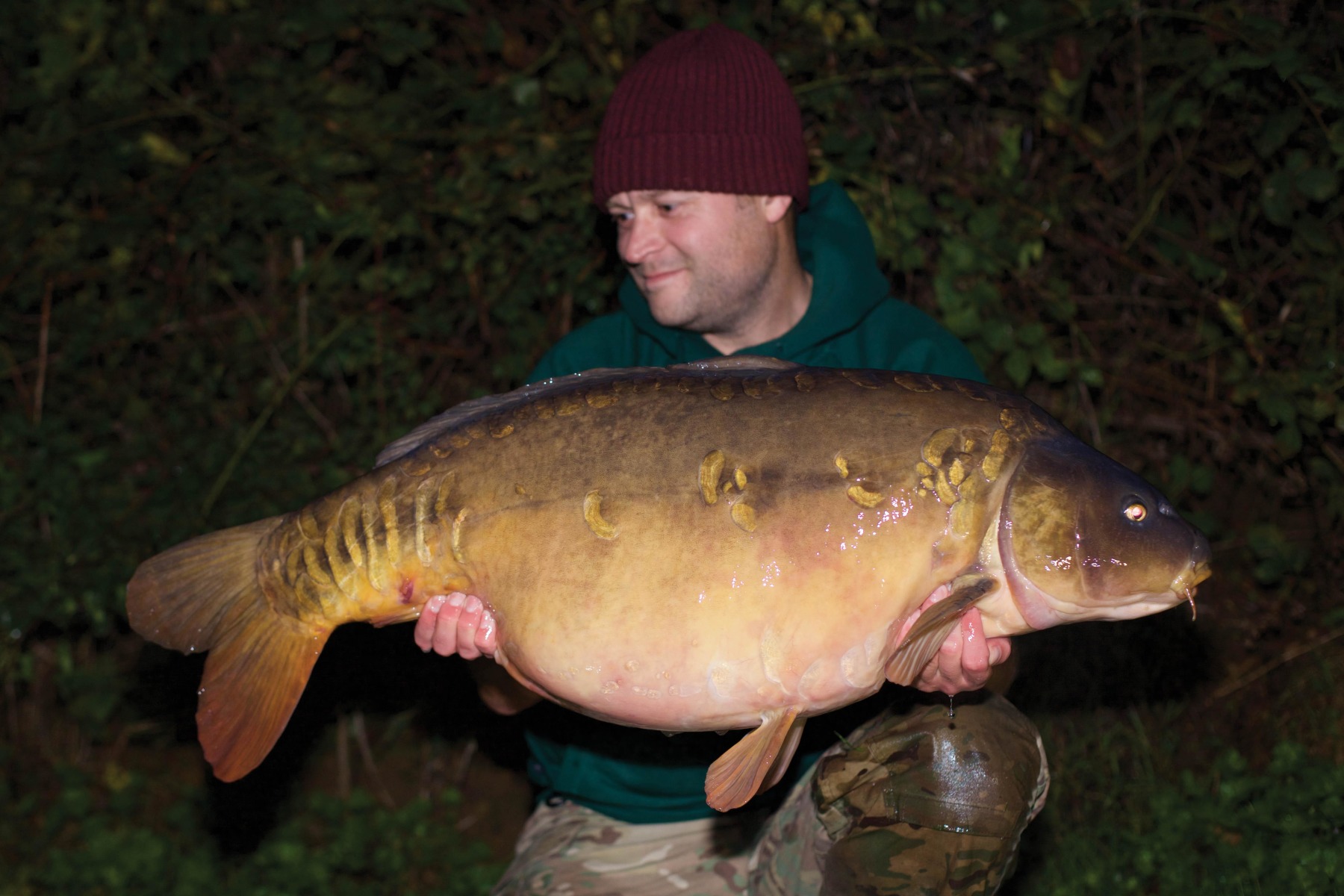
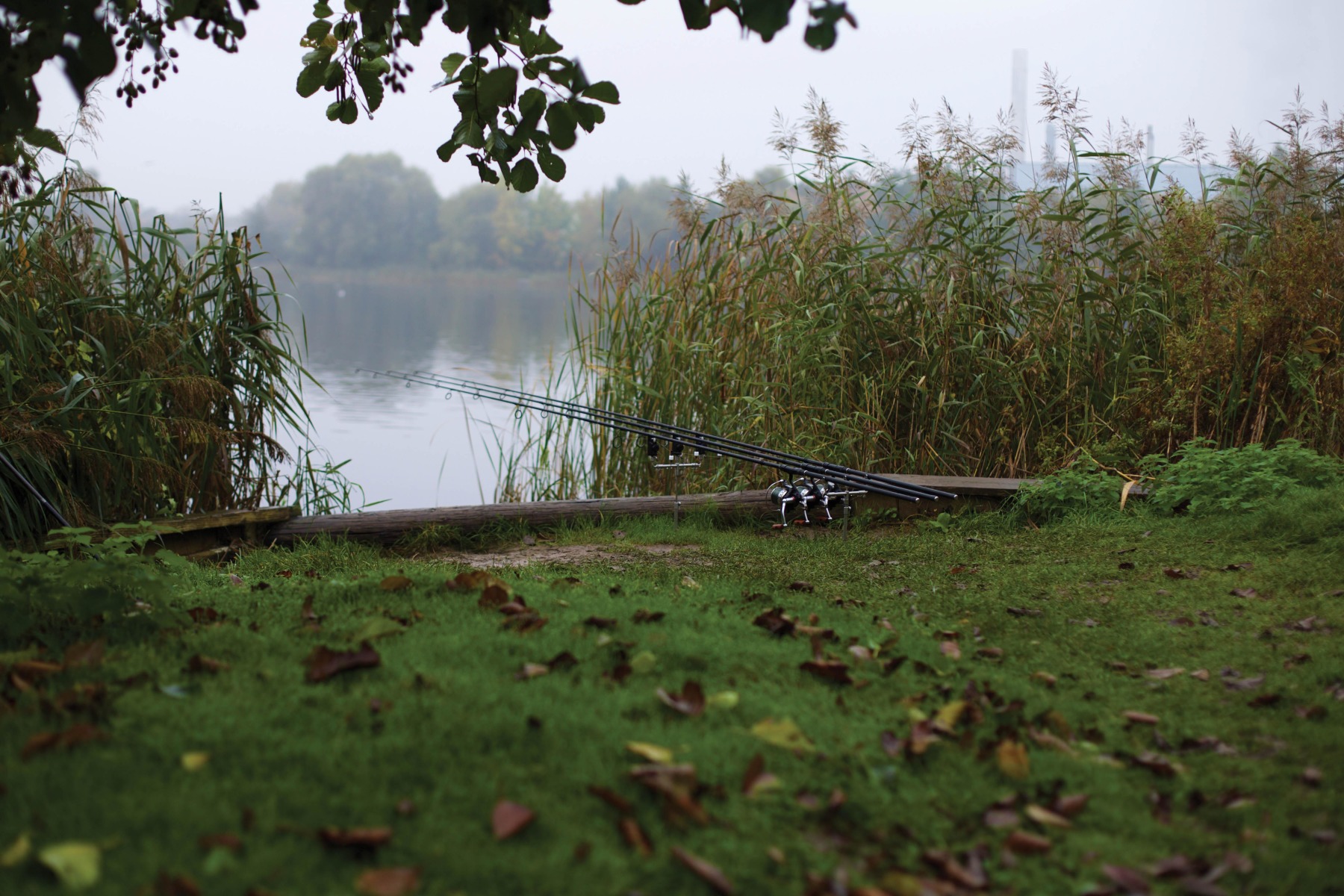
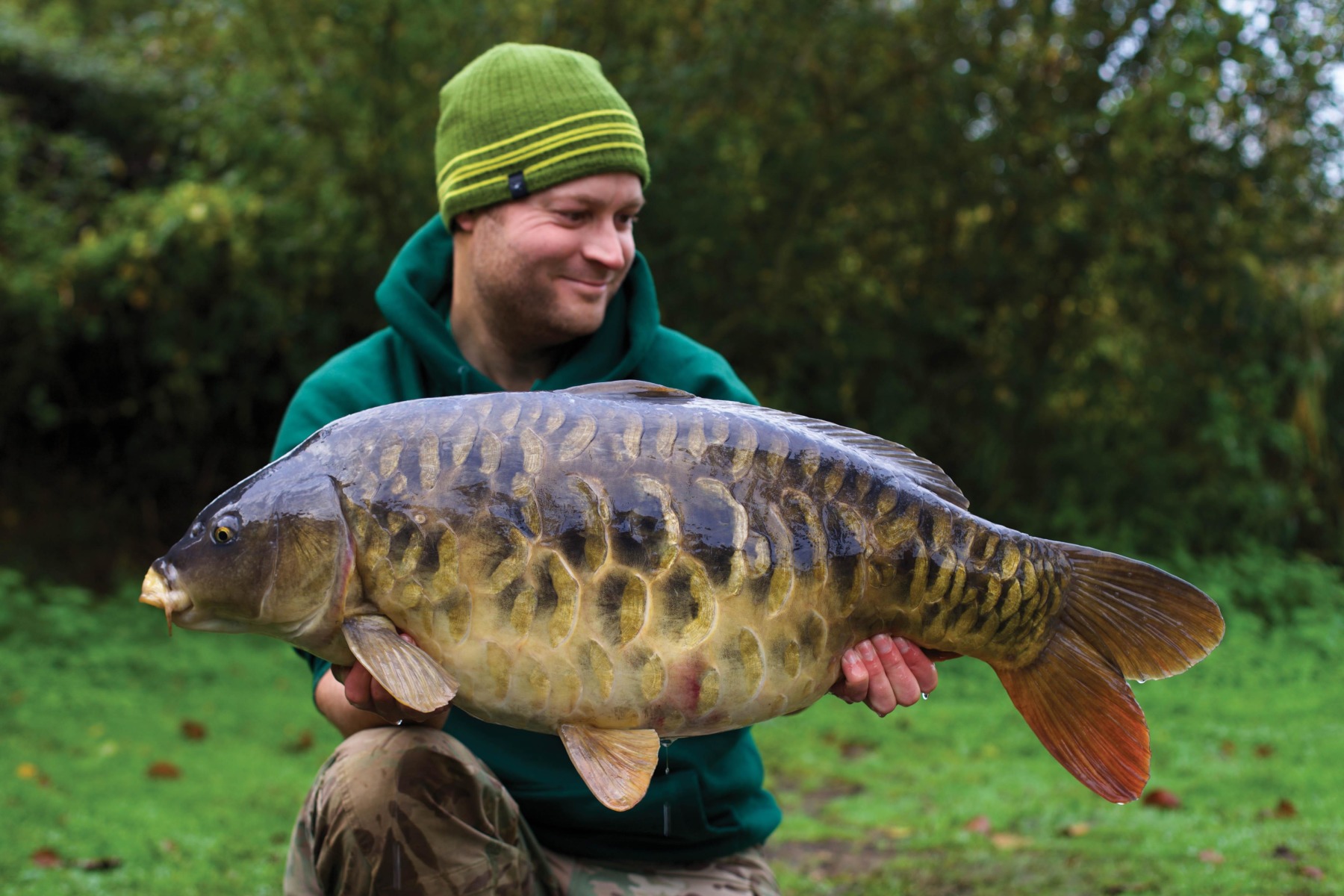
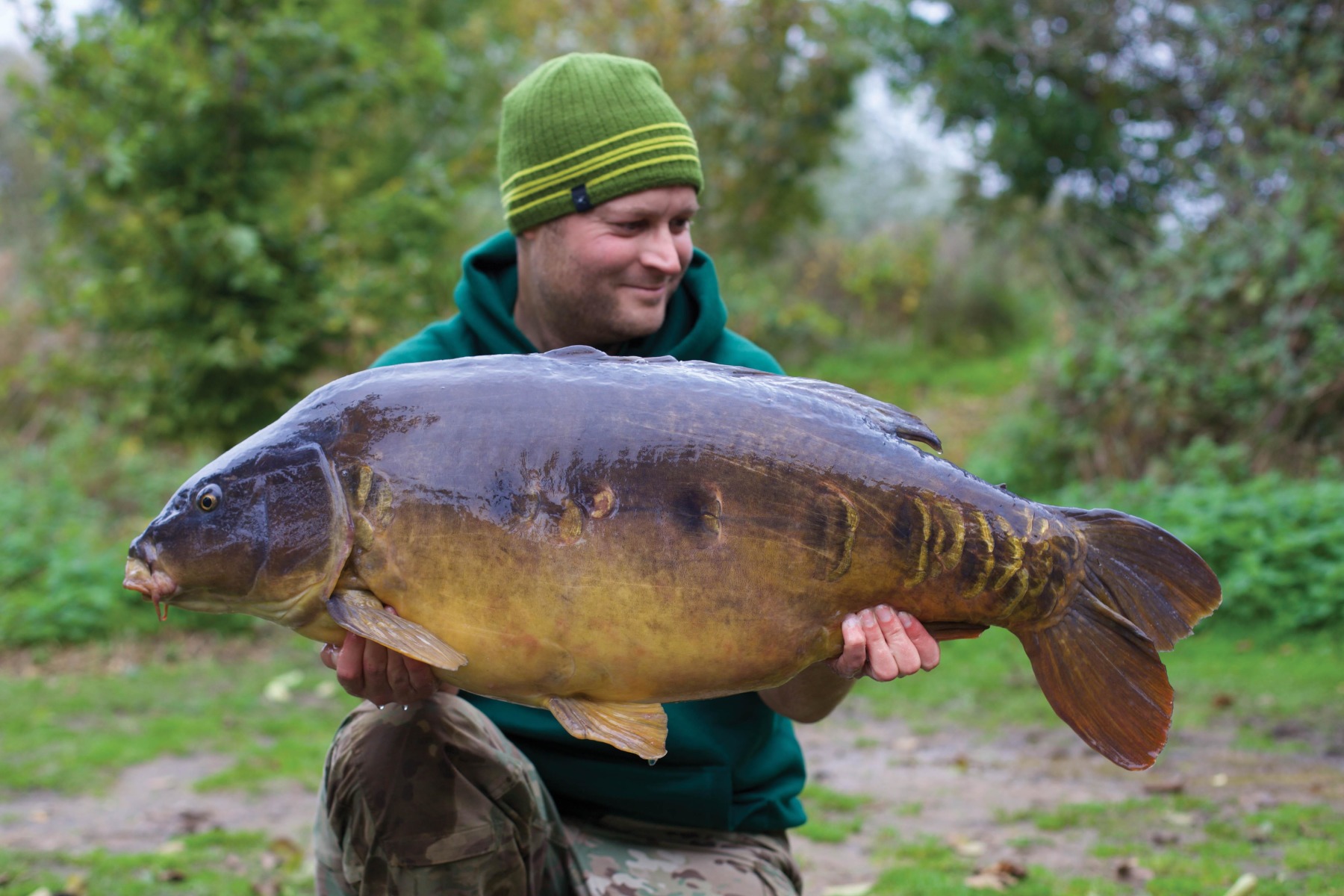
The following week - the second in November - I was back, and this time the weather was spot on. The cold, high-pressure conditions were replaced by a low-pressure front. Undeterred by the blank, I was back in the Dugout, and once again, by early lunchtime I had all three rods positioned on the silty spot. I saw two shows later that afternoon, both were at very long range and off to my right between the Dugout and the Original swim; they were enough to keep my confidence up.
After an uneventful first night, I went on to catch a chestnut-coloured 28lb 9oz mirror the following afternoon, and a couple of hours into the darkness, the right-hand rod was away again. Thankfully, I got the carp back to the margins pretty easily, but once there it continued to hug the bottom for what felt like an age. After it eventually tired, I seized the opportunity with the net and landed a cracking mirror with a heart-shaped tail. She went 35lb 13oz on the Reubens and had three sovereign-sized scales on her shoulder. She was a truly lovely mirror, one I had never seen a photo of previously.
The pit really does hold an amazing head of big carp, and depending on who you talk to, a stock of around 200 fish might be mentioned. In addition to the forties I referred to earlier, there is a serious head of upper-thirties. The targets of many are two carp in particular. The first is Harry’s, a long upper-forty with a cluster of scales in the centre of its flank. The second is a relic of a mid-forty mirror that lived in the pit back when it was a sailing lake. I would have been over the moon with either, but was really hoping to meet the latter. However, being realistic, given the stock, it really is a numbers game. To have a real chance of landing either of these much sought-after carp, you really do need to catch consistently, and that is exactly what I was trying to do.
I blanked the following session; it was chilly with daytime temperatures not getting above 5 degrees. By my next trip at the end of November, however, a large, low-pressure system had arrived. It was very mild, with temperatures around 11 degrees accompanied by drizzly rain. A south-westerly wind pushes across the lake into the Woods swim on the river bank, which also fishes out to the central area of the pit. The Woods swim was free and I quickly parked up behind it. You can park behind your pegs on three banks - a nice perk! The mild weather really stirred the carp up. Again, I was fishing all three of my rods to a clear, silty spot. I ended up landing seven carp in total: five twenties and two thirties to 38lb 12oz - at one stage I had three fish in the net at once! I think some credit needs to go to the bait here; it was crystal clear that they had a real taste for it by this time. One of the key traits of Cell is that it is an all-season bait, i.e. it is just as effective in cold water as it is at the peak of summer, and having applied the bait all year on the pit, I was really starting to reap the rewards!
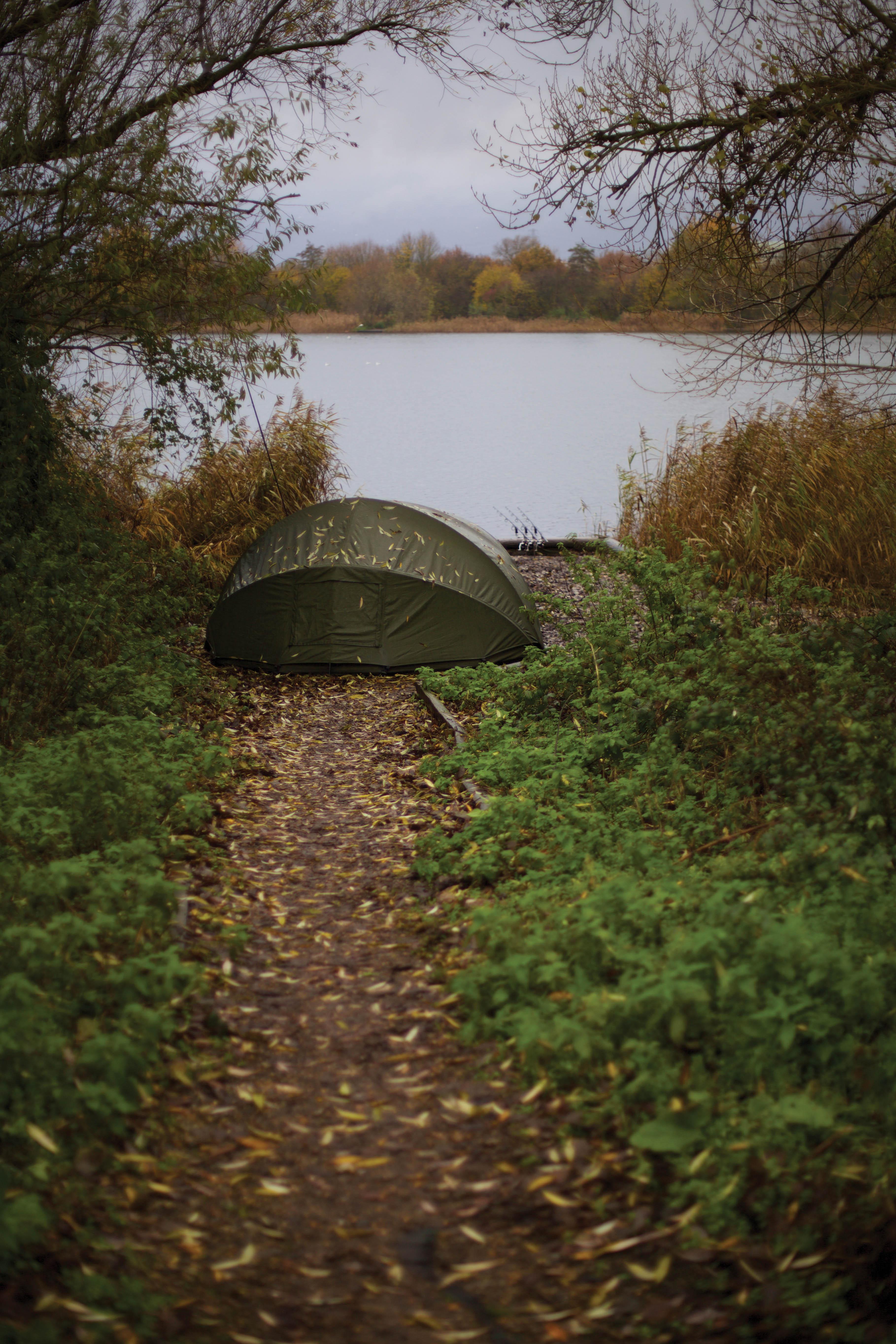
A cold spell coincided with the start of December, but I arrived at the pit just as a mackerel sky signalled a change. I got back in the Woods swim and four more lovely carp came my way, the biggest being a football-shaped common of 35lb 1oz. It was some of the most prolific angling I have ever experienced, and great fun. Having fished the Horton Church Lake the previous year where you are forced to record every capture in a log at the lodge, it was lovely being able to do self-takes and keep captures as quiet as possible… I felt that I was getting ever closer to meeting one of my targets, and shouting about captures is never a good idea if you want to keep a nice run going!
For both my next two trips I was in the Fiend swim. The first was in stormy conditions with winds gusting to a hairy 50mph. That session produced another four mirrors to 30lb 8oz. The second session, however, was simply epic! I arrived around 9 a.m. to be met by relatively calm conditions - although these were due to change. They allowed me to quickly get the rods and bait into position. By early afternoon, the southerly had arrived, and shortly after I saw the first show out in the central zone. An hour or so later, I was on the phone to Mark when a carp showed right over my left-hand rod. I said to Mark, “I think I’m going to get a take,” …just seconds later, one of the rods was away! Initially, it came in fine, but then I started to feel a horrible grating sensation as she hugged the back of one of many gravel humps in the lake. I eased right up and allowed her to take line. This worked, and she kited off to the right and cleared the feature. A slow and heavy fight had me convinced that I playing one of the lumps, and eventually I netted a really thickset mirror of 39lb 2oz.
The wind then picked up to around 25mph, gusting at times to 45mph, and the bites just kept coming. By the finish I had hooked a total of 12 carp and had landed nine. These included two of the original stock, a couple of beautiful heavily scaled mirrors, and a real character of a dumpy linear at 30lb 10oz linear. It was another real red-letter session… a crazy amount of action considering it was late December.
One of the losses, though, really haunted me. I am not into amateur dramatics, but I am unashamed when I say that I threw my rod down. After playing a very heavy carp for over twenty minutes, I suffered a hook-pull after the fish found weed down the marginal shelf. As I touched on before, I feel that you really did need to catch consistently to get through to the rarer ones… I really hoped that I hadn’t just messed up my chance!
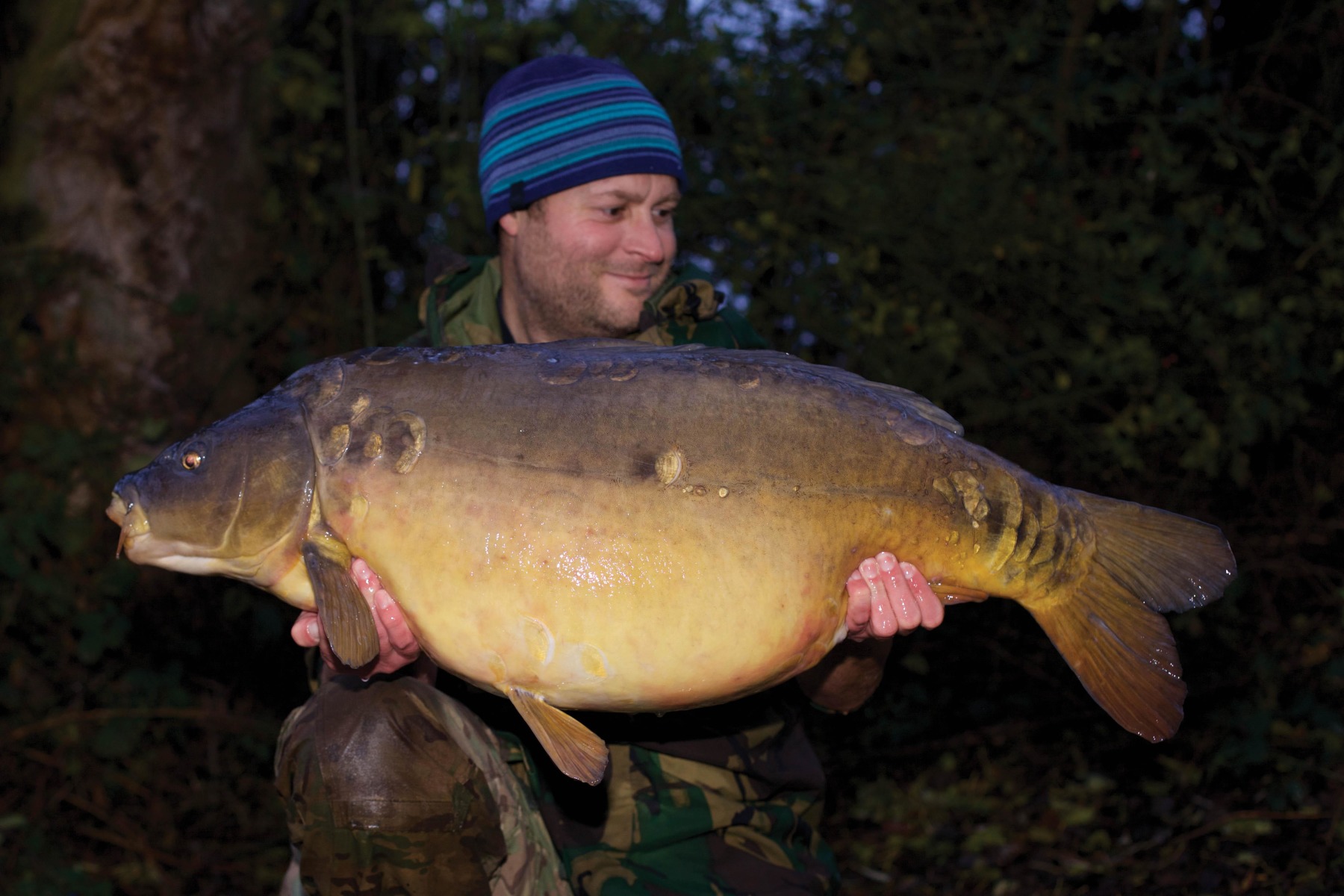
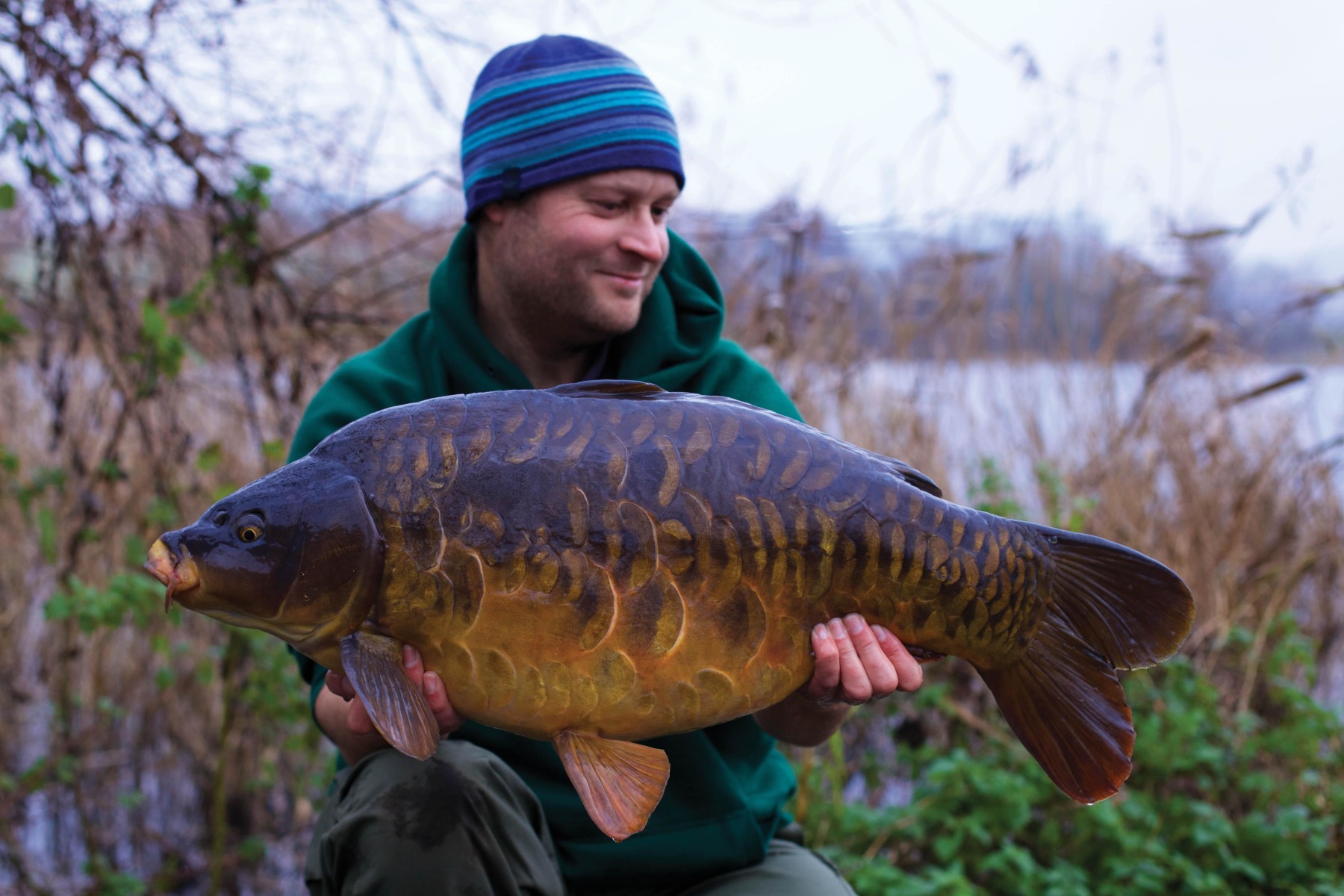
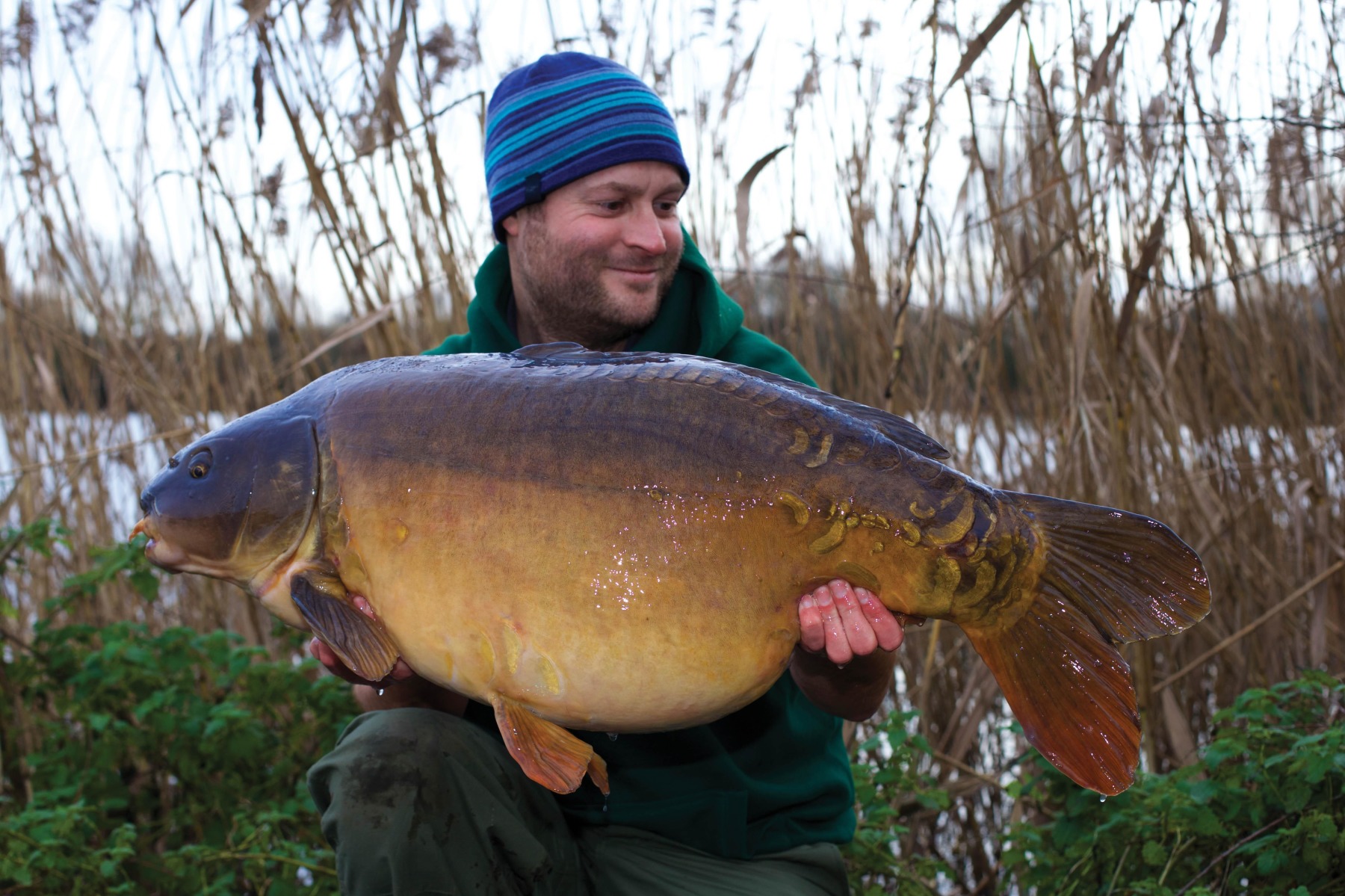
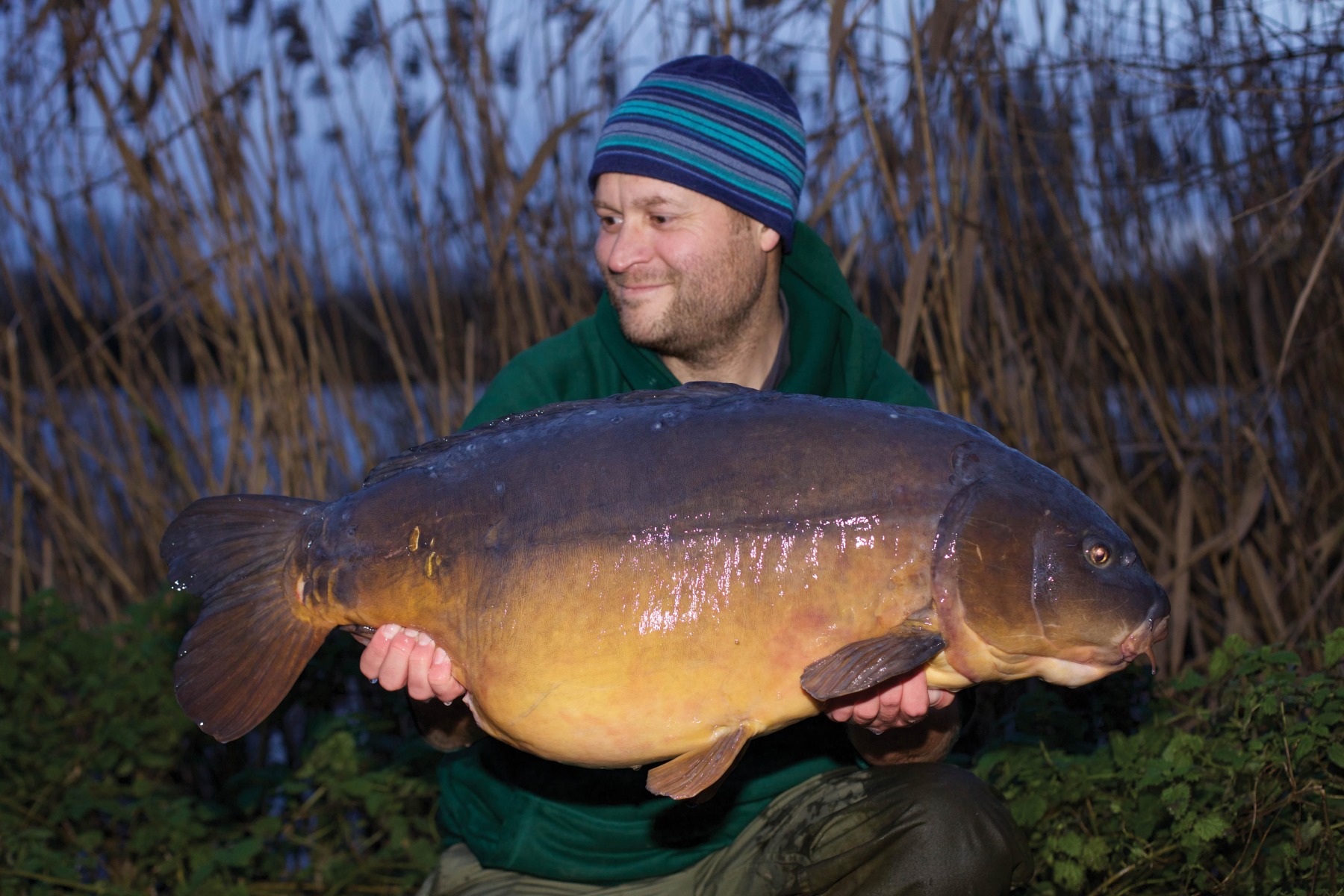
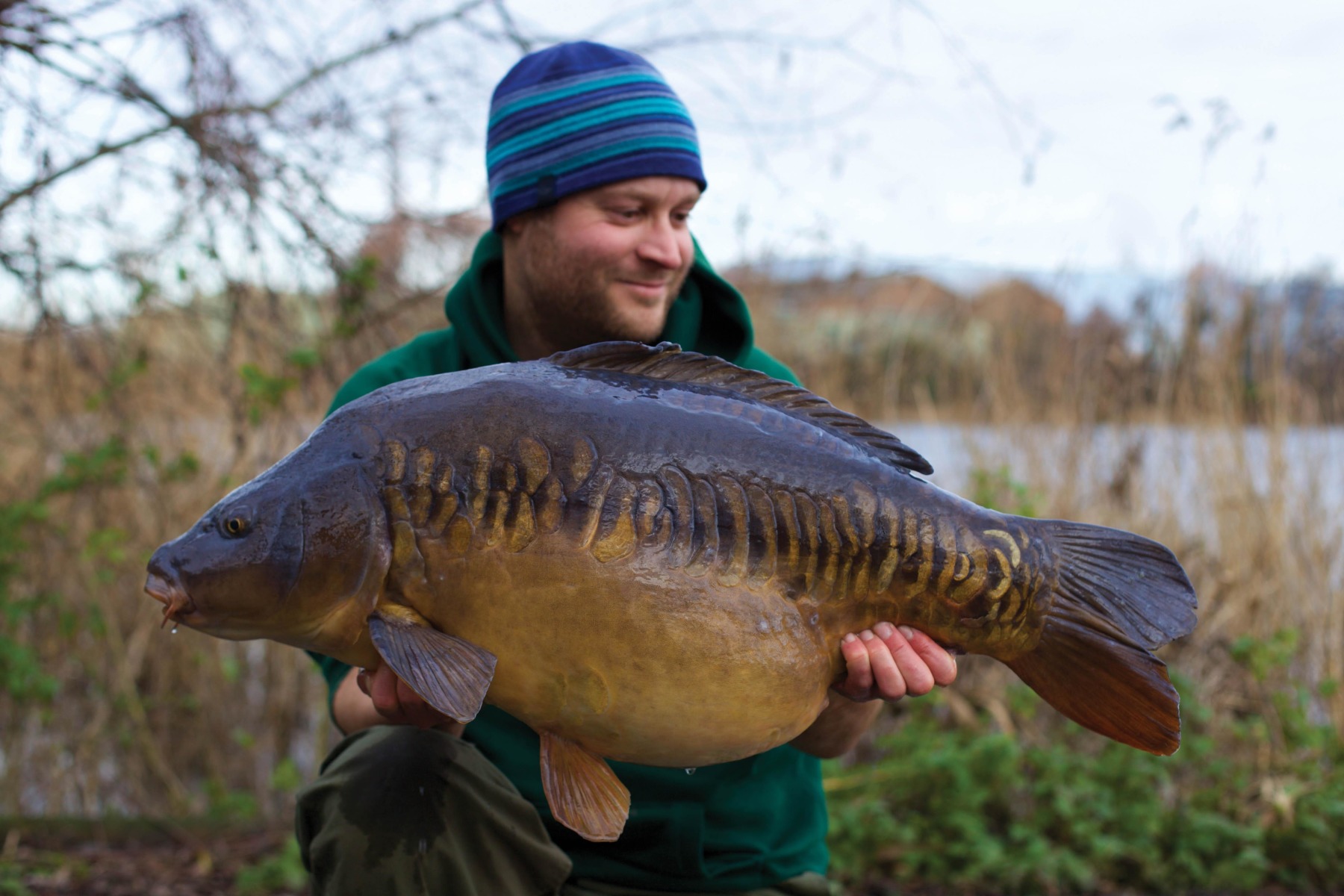
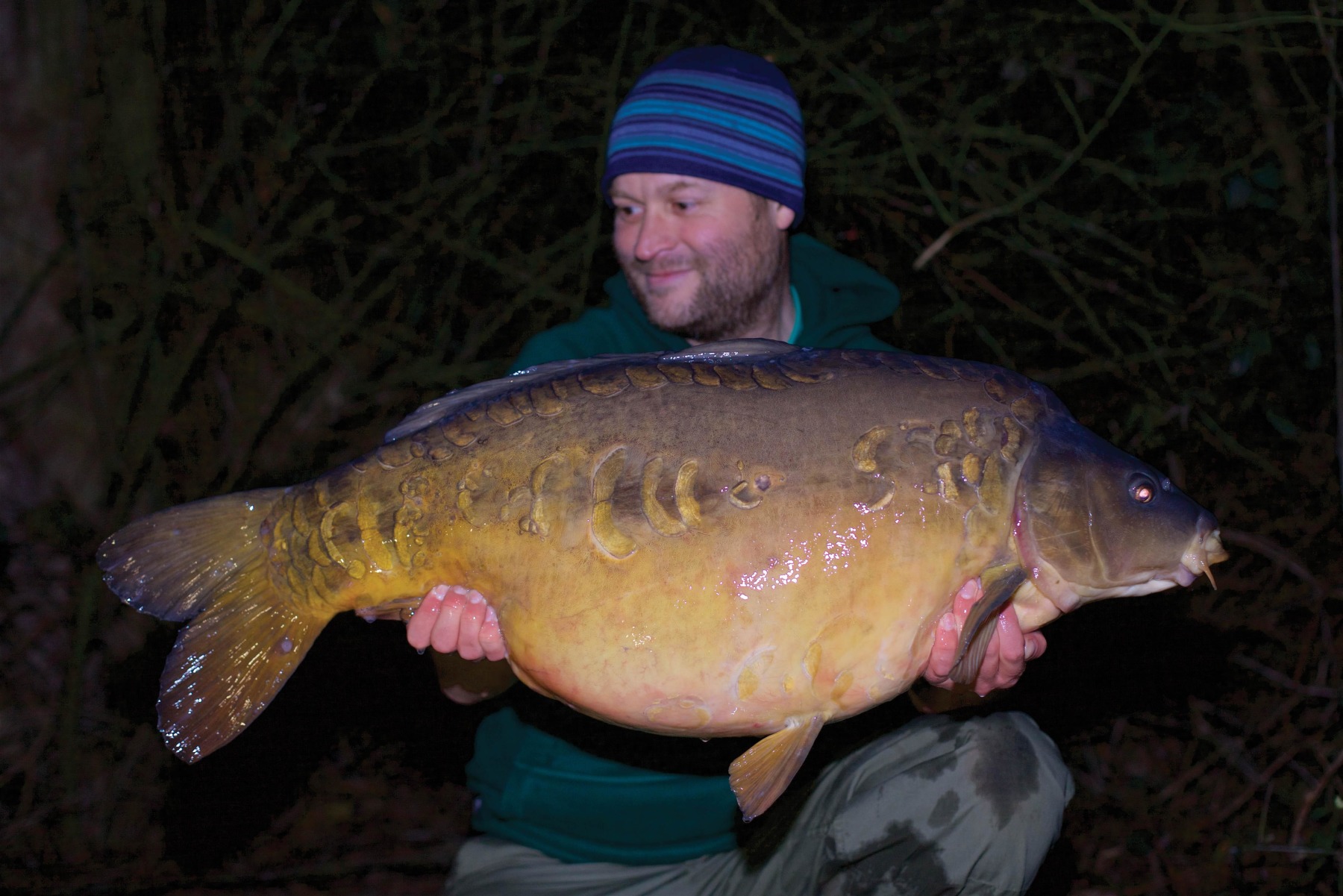
After the Christmas celebrations, I returned to the lake just before New Year. I got back in the Fiend, but in very different weather conditions, with higher pressure and very light winds. I blanked. I think we might be seeing a pattern here: they really did get switched on during the big low-pressure systems.
At the beginning of January, I returned to the lake and managed to get back in the Woods, the first time I had been able to do so since my catches there at the start of December. It was nice and mild, with the car thermometer showing 12 degrees. Once again, I got the rigs and bait into position in the relatively light winds, but by darkness we were being battered by a 40mph south-westerly (as confirmed by my weather app). Just before 6 p.m., I hooked an animal of a carp at range that immediately took line. It turned out to be a mirror of 36lb 4oz with lovely scaling along its lateral line.
The temperature stayed in double-figures all night, but the wind died off at dawn. I had been managing to fend off the many coots and tufties on the pit throughout the winter by using one of those high-power, red LED torches. To be fair, it had been pretty effective, but in the still conditions, a handful of persistent coots had found my baited area and I just couldn’t scare them off. Mark, who was fishing in the Flame swim next-door, came down for a chat, and every now and again I got a bleep from a Neville as one of the pesky coots hit my line. We were standing chatting when my middle Neville let out yet another single bleep. On this occasion, however, the line was clearly tightening, and I reached the rod just as the line pulled from the clip and the alarm started to one-tone.
The carp immediately started to kite off to the right. Whilst I had hooked it from open water, due to the presence of reedbeds in both the left- and right-hand margins, the Woods is a relatively tight swim. All looked doomed; it had got way too far off to my right and looked as though it was about to reach the reeds. Then, however, and of its own accord, it turned at the last moment. Once in front of the swim, we could see a big mirror twisting and turning in the crystal-clear water. After my loss in the Fiend, I was a bag of nerves, and Mark did nothing to help by repeatedly reminding me how big it was! Thankfully, the hook-hold proved solid, and once it finally tired, Mark slid the net under a large-framed mirror. Peering into the net, I was able to confirm the capture of a battle-scarred relic of a fish. She was my seventy-fifth from the pit that season, and what an old carp! The Reubens showed a weight of 44lb 11oz, and she looked superb as I held her aloft for the camera, her flanks awash with reddish-brown hues. On cloud nine, I had just finished dinner that evening when I received another take. It resulted in mirror of 39lb 5oz, and its appearance reminded me of the old, original strain that inhabit Elstow.
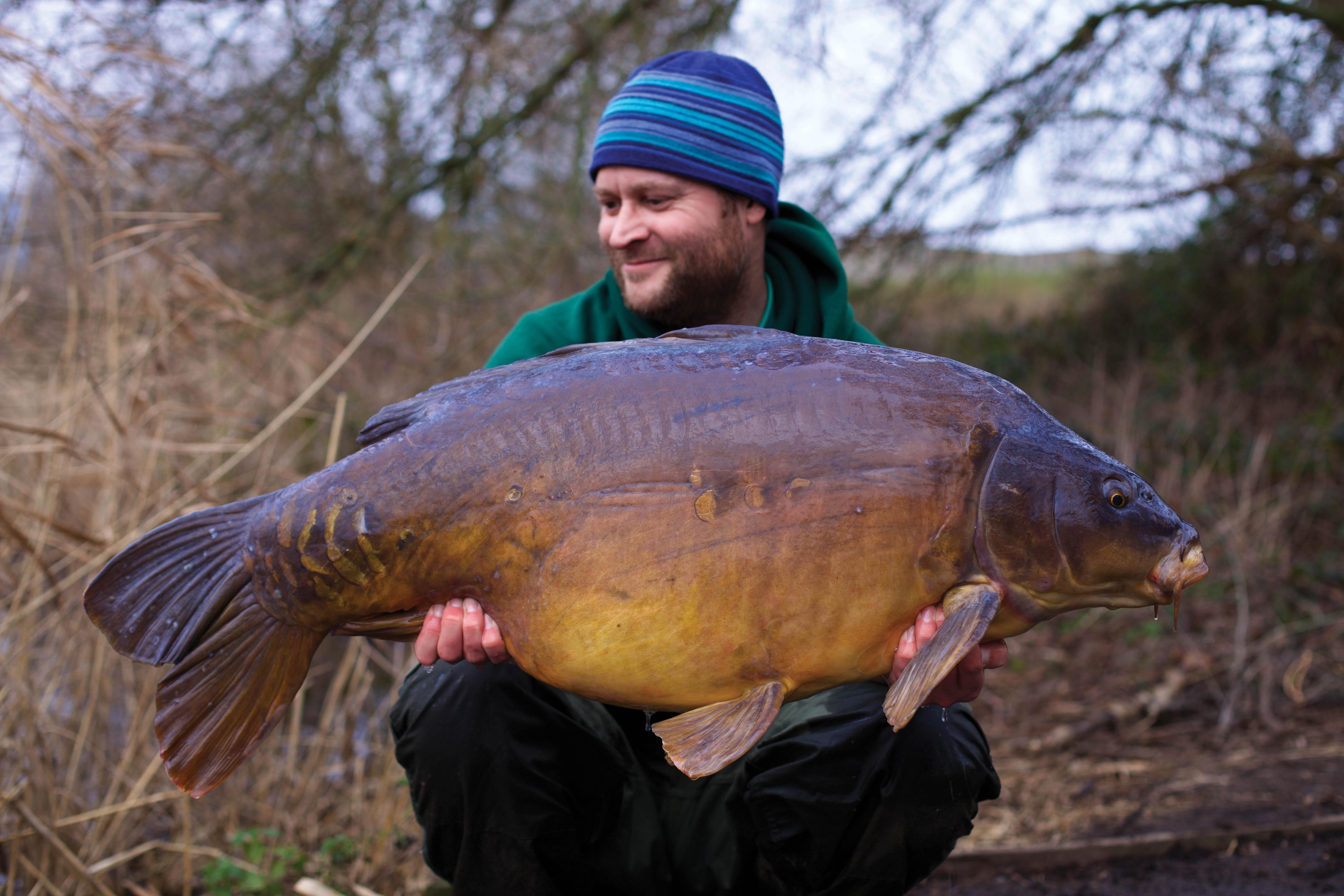
During the winter of 2019/2020, it felt like storms were hitting the UK on a weekly basis! The following week, it was the turn of Storm Brendan. I managed to get back in the Woods, and once again I had the rigs and bait in position by early afternoon. It wasn’t easy, what with the wind already gathering in strength as the pressure plummeted. Just after 6 p.m., my right-hand rod was away. It was a surreal fight as 50mph gusts battered both me and the rod. In truth, given the conditions, I couldn’t really feel the carp, and I just did my best to keep it coming towards me. The fight ground to a halt a couple of times as the fish found the remnants of old weedbeds, but eventually I managed to land the common known as Split Pec at 40lb 10oz. I photographed her behind my bivvy in a bid to shelter from the wind!
A drop-back bite the following morning resulted in a lovely 36lb 4oz mirror with a distinctive cluster of scales in the centre of its flank. Before I left the lake for what would be the final time, I landed a 22lb mirror; it had been a truly stellar season. I had been privileged to catch some lovely carp, but catching the old girl in January really was the icing on the cake. I briefly considered keeping my ticket for a second season. Catching Harry would have been nice, but I quickly dismissed the idea. I had already had a bunch of repeat captures, and there is always a new challenge around the corner…
